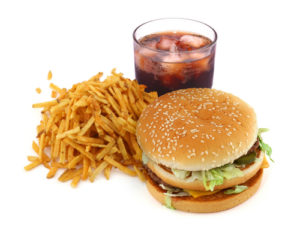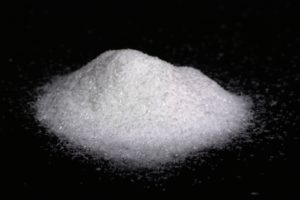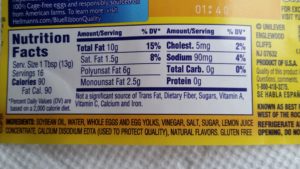I've always recommended that people eat as many unprocessed foods as possible, and that one should always read the ingredient list when buying processed and prepared foods. The Center for Science in the Public Interest strongly urges that people avoid the following food ingredients: aspartame, food dyes, mycoprotein (Quorn), and partially hydrogenated oils (trans fat). The following article may be an eye opener for those who think that the FDA (Food and Drug Administration) carefully regulates what goes into our food. Link to the full article to read all the health concerns with mycoprotein (Quorn), Epigllocatechin-3-gallate (EGCG), and carageenan. From The Washington Post:
Food additives on the rise as FDA scrutiny wanes
The explosion of new food additives coupled with an easing of oversight requirements is allowing manufacturers to avoid the scrutiny of the Food and Drug Administration, which is responsible for ensuring the safety of chemicals streaming into the food supply.
And in hundreds of cases, the FDA doesn’t even know of the existence of new additives, which can include chemical preservatives, flavorings and thickening agents, records and interviews show. “We simply do not have the information to vouch for the safety of many of these chemicals,” said Michael Taylor, the FDA’s deputy commissioner for food.
The FDA has received thousands of consumer complaints about additives in recent years, saying certain substances seem to trigger asthmatic attacks, serious bouts of vomiting, intestinal-tract disorders and other health problems.
At a pace far faster than in previous years, companies are adding secret ingredients to everything from energy drinks to granola bars. But the more widespread concern among food-safety advocates and some federal regulators is the quickening trend of companies opting for an expedited certification process to a degree never intended when it was established 17 years ago to, in part, help businesses.
A voluntary certification system has nearly replaced one that relied on a more formal, time-consuming review — where the FDA, rather than companies, made the final determination on what is safe. The result is that consumers have little way of being certain that the food products they buy won’t harm them. “We aren’t saying we have a public health crisis,” Taylor said. “But we do have questions about whether we can do what people expect of us.”
In the five decades since Congress gave the FDA responsibility for ensuring the safety of additives in the food supply, the number has spiked from 800 to more than 9,000, ranging from common substances such as salt to new green-tea extracts. This increase has been driven largely by demand from busy Americans, who get more than half their daily meals from processed foods, according to government and industry records.
Within the past six months, top officials at the FDA and in the food industry have acknowledged that new steps must be taken to better account for the additives proliferating in the food supply.
For new, novel ingredients — or when approved additives are used in new ways — the law says companies should seek formal FDA approval, which must be based on rigorous research proving the additive is safe. The agency uses the phrase “food additive,” in a narrow legal sense, to apply to substances that get this approval.
But many other additives are common food ingredients — vinegar is considered a classic example. The law allows manufacturers to certify, based on research, that such ingredients are already Generally Recognized as Safe, or GRAS. For both types of additives, FDA scientists initially conducted detailed reviews of the company’s research. The agency also published its own evaluation of that research in the Federal Register.
This oversight system shifted dramatically in 1997. In response to a shortage of staff members and complaints from industry that the process was too cumbersome and did not improve food safety, the FDA proposed new rules. The agency told companies that were going the GRAS route — which turned a years-long process into one of months — that they no longer would have to submit their research and raw data. The companies can share just a summary of their findings with the agency.
The changes didn’t work out as planned. For starters, most additives continued to debut without the FDA being notified. Moreover, companies that did choose to go through the FDA oversight process largely abandoned the formal approval route, opting instead for the new, cursory GRAS process, even for additives that could be considered new and novel, according to agency documents and an analysis of those records by the Natural Resources Defense Council.
An average of only two additive petitions seeking formal approval are filed annually by food and chemical companies, while the agency receives dozens of GRAS notifications, according to an NRDC analysis of FDA data. Hundreds of other food chemicals and ingredients have been introduced without notifying the FDA at all, according to agency officials, trade journals and food safety groups.
Companies often bypass the FDA altogether. Under the rules, companies may make their own GRAS determination. Sharing it with the agency and getting it to sign off is voluntary. This is the opposite of what the overisght law intended, the FDA’s Taylor said.
Even when the FDA approves a new additive or signs off on a company’s GRAS determination, a safe ingredient can turn dangerous if its use becomes more widespread than the agency envisioned. And under the rules, the agency has little way of monitoring this threat after the initial introduction of the additive, called “post-market.”
During the initial review, the FDA sets limits for how much of a chemical or ingredient can be used in a particular product. But the cumulative consumption can soar as the additive is used in more and more types of food and beverages.
 The studies finding health harms from ultra-processed foods keep coming. Ultra-processed foods are food products manufactured with all sorts of ingredients (additives) not normally found in our kitchens. Examples of such ingredients are: emulsifiers, carrageenan, mono- and diglycerides, soy lecithin, polysorbate, cellulose, colors, titanium dioxide, high fructose corn syrup, hydrogenated oils, dextrose, whey protein, nitrates, flavors (artificial and natural), colors, etc.
The studies finding health harms from ultra-processed foods keep coming. Ultra-processed foods are food products manufactured with all sorts of ingredients (additives) not normally found in our kitchens. Examples of such ingredients are: emulsifiers, carrageenan, mono- and diglycerides, soy lecithin, polysorbate, cellulose, colors, titanium dioxide, high fructose corn syrup, hydrogenated oils, dextrose, whey protein, nitrates, flavors (artificial and natural), colors, etc.
 Most Americans eat highly processed or ultra-processed foods every single day, with most of their daily calories from them! There are all sorts of health risks from these foods, with a recent study finding an overall increased risk of cancer, as well as prostate and breast cancer.
Most Americans eat highly processed or ultra-processed foods every single day, with most of their daily calories from them! There are all sorts of health risks from these foods, with a recent study finding an overall increased risk of cancer, as well as prostate and breast cancer. Finally... two states (California and New York) are seeking to ban 5 chemicals frequently added to food that are known to cause health problems (cancer, neurological problems, hormone disruptors). They have no reason to be in food (and yes, safer alternatives exist). The five chemicals of concern are: red dye 3, titanium dioxide, potassium bromate, bromated vegetable oil, and propylparaben.
Finally... two states (California and New York) are seeking to ban 5 chemicals frequently added to food that are known to cause health problems (cancer, neurological problems, hormone disruptors). They have no reason to be in food (and yes, safer alternatives exist). The five chemicals of concern are: red dye 3, titanium dioxide, potassium bromate, bromated vegetable oil, and propylparaben. Did you know that some other countries have stricter laws on food additives, drugs, and pesticides than the US? This is especially true with the European countries. It is especially aggravating to read that manufacturers sell foods with one set of ingredients in the US and a better set of ingredients in Europe. (Could it be because the FDA has such nice cozy relationships with Big Ag and lobbyists representing big chemical companies?) So... what can the ordinary person do? Read labels carefully. And try to buy as much organic food as possible, or buy from local farmers where you can find out how they are growing crops or raising animals.
Did you know that some other countries have stricter laws on food additives, drugs, and pesticides than the US? This is especially true with the European countries. It is especially aggravating to read that manufacturers sell foods with one set of ingredients in the US and a better set of ingredients in Europe. (Could it be because the FDA has such nice cozy relationships with Big Ag and lobbyists representing big chemical companies?) So... what can the ordinary person do? Read labels carefully. And try to buy as much organic food as possible, or buy from local farmers where you can find out how they are growing crops or raising animals.
 This research suggests that emulsifiers (which are added to most processed foods to aid texture and extend shelf life) can alter the
This research suggests that emulsifiers (which are added to most processed foods to aid texture and extend shelf life) can alter the